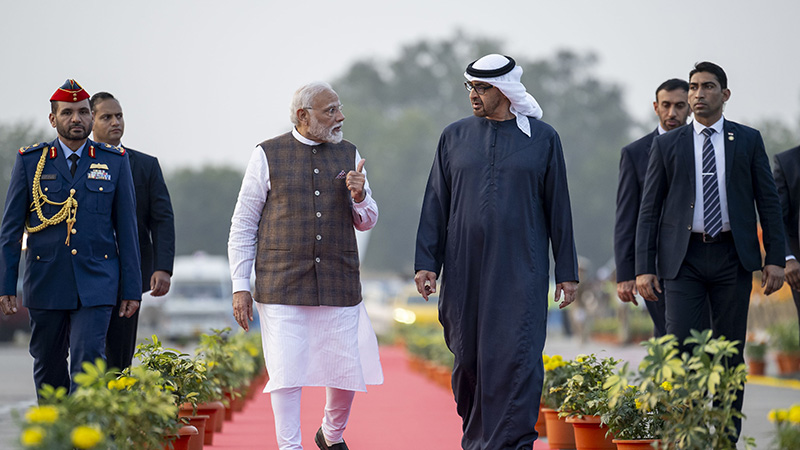UAE President His Highness Sheikh Mohamed bin Zayed Al Nahyan, popularly known as MBZ, arrived in Gujarat on Tuesday to a warm welcome. As a special gesture, he was received at the airport by Indian Prime Minister Narendra Modi and the two leaders shared a warm hug. On his arrival, the UAE President was accorded a guard of honour and later as the two leaders left the airport, there was an impressive roadshow that had been put in place for MBZ. The roadshow took place from Ahmedabad Airport to Gandhinagar, where the Vibrant Gujarat Summit is scheduled to begin on Wednesday.
Modi while welcoming MBZ posted on X, “Welcome to India my brother (UAE President Sheikh Mohamed). It’s an honour to have you visit us.”
The UAE President is the Chief Guest at the Vibrant Gujarat Summit which will be inaugurated by Modi. But today itself saw the signing of several MoUs between India and the UAE. Both leaders also held discussions which were the fourth meeting between the two leaders in less than seven months, indicative of the speed at which the relationship is progressing.
While the grand optics of the very warm welcome to the UAE President by Modi was there for all to see, it is equally important to understand the factors that today make the India-UAE ties one of the most promising for the future.
India’s ties with the UAE are multi-layered and one of those few in which there is an equally strong economic and strategic aspect. Trade between India and the UAE reached $85 billion in 2022, making the UAE India’s third-largest trading partner and India the UAE’s second-largest. Further the signing of the Comprehensive Economic Partnership Agreement (CEPA) in 2022 has lent greater strength to this economic partnership.
The strategic part of the relationship has also grown stronger over the years. The I2U2 grouping of Israel, India, the United Arab Emirates and the United States is one of the most significant developments in the region. It not only brings India and the UAE closer, but it also helps them both act as the bridge of the region to the rest of the world.
Similarly, the ambitious India-Middle East-Europe Economic Corridor (IMEEC) sees a robust participation of both India and the UAE to connect the regions of Asia and the Middle East to Europe. Of course, from a purely strategic perspective, both I2U2 and IMEEC have retreated to the background as the conflict in Gaza rages on. But, with time, as the Middle East returns to a place of reduced tensions, work on both I2U2 and IMEEC will once again commence.
There is also the thrust which this bilateral relationship has received due to the personal attention and bonhomie shared by its two leaders. Modi, since 2014, has visited the UAE six times and he is again scheduled to be in Abu Dhabi next month for two landmark events: a massive expatriate event and second the inauguration of the BAPS Hindu temple. The UAE President has also returned the gesture and this is his fourth visit to India since 2016.
What has been remarkable in this relationship and the reason most analysts are upbeat about its future is the many aspects that ties the two nations together. Economic, strategic, people-to-people ties, leadership bonhomie and a mutual respect for the other’s world viewpoint. One can make a safe bet that this is a relationship that is set to grow in strength in the coming years. – The writer is Executive Editor of Nrifocus.com


Leave a Reply